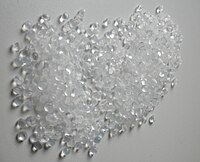
Photo from wikipedia
Density functional theory has been used to elucidate the mechanism of Pd copolymerization of cyclopropenone with ethylene. The results reveal that introducing ethylene and cyclopropenone to Pd catalyst is thermodynamically… Click to show full abstract
Density functional theory has been used to elucidate the mechanism of Pd copolymerization of cyclopropenone with ethylene. The results reveal that introducing ethylene and cyclopropenone to Pd catalyst is thermodynamically feasible and generates the α,β-unsaturated ketone unit (UnitA). Cis-mode insertion and Path A1a are the most favorable reaction routes for ethylene and cyclopropenone, respectively. Moreover, cyclopropenone decomposition can generate CO in situ without a catalyst or with a Pd catalyst. The Pd-catalyzed decomposition of cyclopropenone exhibits a lower reaction barrier (22.7 kcal/mol) than its direct decomposition. Our study demonstrates that incorporating CO into the Pd catalyst can generate the isolated ketone unit (UnitB). CO is formed first; thereafter, UnitB is generated. Therefore, the total energy barrier of UnitB generation, accounting for the CO barrier, is 22.7 kcal/mol, which is slightly lower than that of UnitA generation (24.0 kcal/mol). Additionally, the possibility of copolymerizing ethylene, cyclopropenone, and allyl acetate (AAc) has been investigated. The free energy and global reactivity index analyses indicate that the cyclopropenone introduction reaction is more favorable than the AAc insertion, which is consistent with the experimental results. Investigating the copolymerization mechanism will help to develop of a functionalization strategy for polyethylene polymers.
Journal Title: Polymers
Year Published: 2022
Link to full text (if available)
Share on Social Media: Sign Up to like & get
recommendations!